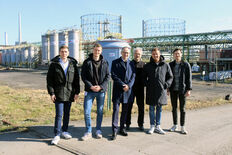- Greenlyte's plant at Marl Chemical Park will cost 25 million euros and occupy 3,000 square meters.
- The plant will capture 1,400 tons of CO2 and produce 200 tons of green hydrogen annually.
- Operations are set to begin by the end of 2026.
- Evonik and partners are developing Germany's first public hydrogen infrastructure.

Investment and Infrastructure
Greenlyte Carbon Technologies is set to invest approximately 25 million euros in a new plant at the Marl Chemical Park. The facility will occupy around 3,000 square meters and is scheduled to commence operations by the end of 2026. This initiative is supported by multi-million euro funding from the "Produktives.NRW" program, co-financed by North Rhine-Westphalia and the European Union.
Production and Technology
The plant will utilize Greenlyte's proprietary direct air capture technology to extract up to 1,400 tons of CO2 from the air annually. Additionally, it will produce about 200 tons of green hydrogen each year. These components will be synthesized into up to 1,000 tons of green eMethanol, a crucial raw material for various chemical processes at the site.
Hydrogen Initiatives
The establishment of Greenlyte's plant is part of broader sustainable hydrogen activities at Marl Chemical Park. As part of the GET H2 initiative, Evonik and other companies are working to create Germany's first publicly accessible hydrogen infrastructure. This includes converting a natural gas pipeline from Marl to Legden and constructing a new section to Scholven.
Innovative Technologies
The site hosts several innovative projects, such as Evonik's Rheticus research project, which uses hydrogen in artificial photosynthesis to produce specialty chemicals from CO2. Additionally, Evonik is investing in a pilot plant for its anion exchange membrane, DURAION®, which is vital for cost-effective green hydrogen production through AEM water electrolysis.
Historical Context
Hydrogen has been integral to Marl Chemical Park's operations for 85 years, with approximately 25,000 cubic meters processed per hour. This expertise will now support a transition to a lower-carbon future.

